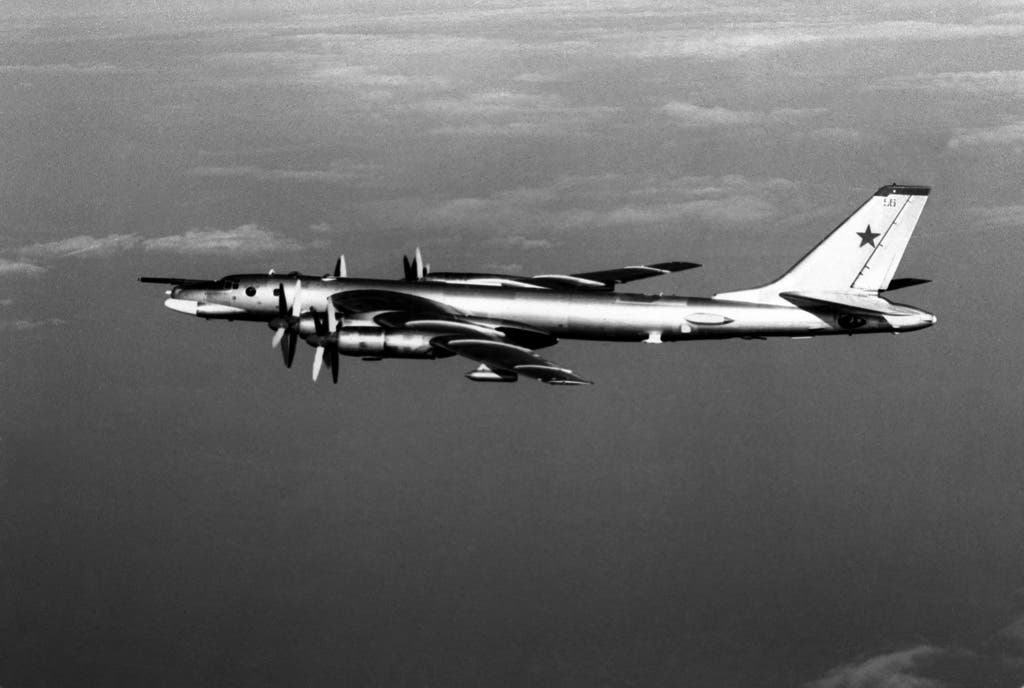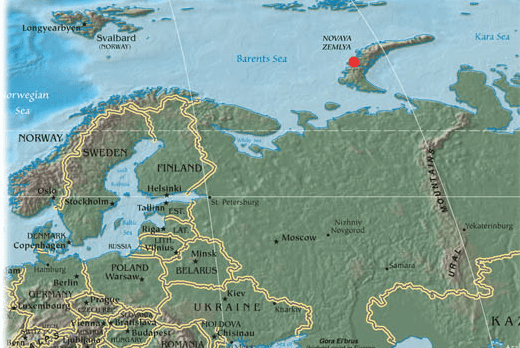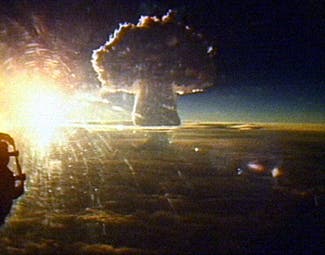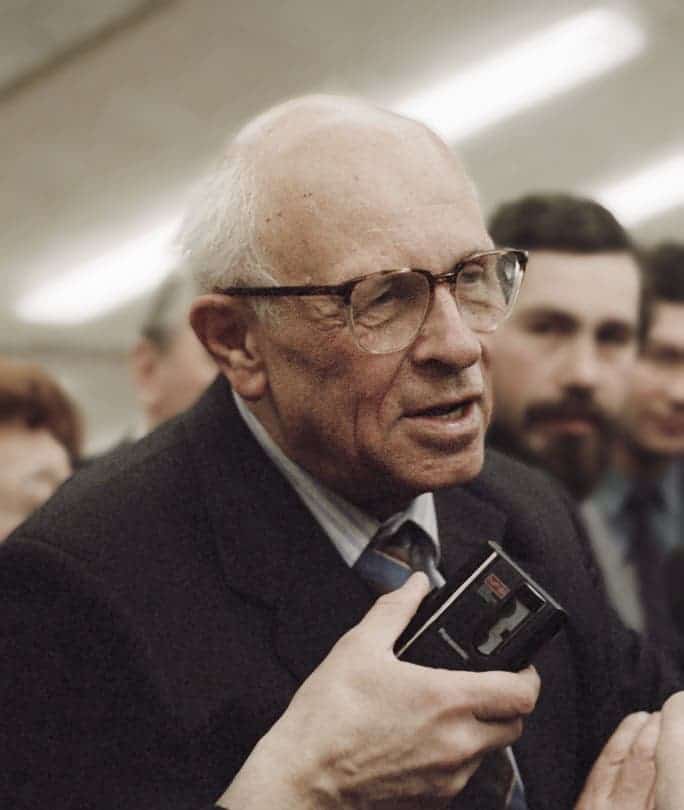
On October 30, 1961, during a cloudy morning, a Soviet bomber dropped a thermonuclear bomb over Novaya Zemlya Island, deep in the Arctic Ocean, in the most extreme northeastern part of Europe. The blast exploded with a staggering yield of 50 megatons (equivalent to 50 million tons of conventional explosives) whose detonation flash could be seen from over 1,000 km away. The bomb, known as the Tsar Bomba (“King of Bombs”), represents the most powerful thermonuclear weapon ever detonated in history. No other bomb as strong as it was ever tested. This is the story of the pinnacle of nuclear weapons.
The bomb of all bombs

In the late 1950s, the Soviets found themselves in a pickle. The Cold War was in full swing and the Americans were clearly winning. Although by that time, the USSR had also developed its own thermonuclear weapons to match the USA arsenal, the Soviets had no effective means of delivering its nukes to US targets.
The post-WWII military doctrine was dramatically disrupted by the introduction of nuclear weapons. Once nukes came into the picture, the US and the Soviet Union, the only nuclear powers at the beginning of the Cold War, each adopted nuclear deterrence as their strategy. Nuclear deterrence represents the credible threat of retaliation to forestall an enemy attack. So if your threat of retaliation isn’t really a genuine threat, you may face total annihilation.
To level the playing field, the Soviets thought of the mother of all bluffs: a weapon so powerful it could level huge cities like New York or Paris in a single blow.
It was Soviet leader Nikita Khrushchev who ordered scientists to start work on the most powerful bomb in the world with development beginning in 1956. In its first phase, the Tsar Bomba went by the code name “product 202”, then from 1960, it was known as “item 602”. In this second phase, nuclear physicist Andrei Sakharov was key to the bomb’s development.
The nuclear scientists settled on a 50Mt thermonuclear warhead design, which is equivalent to nearly 3,300 Hiroshima-era atom bombs. Thermonuclear weapons, also known as hydrogen bombs, are a step above atomic bombs, classed as second-generation nuclear weapons. While atomic bombs employ nuclear fission to release copious amounts of energy from uranium or plutonium, hydrogen bombs employ a second step in which the energy from fission of heavy elements is used to fuse hydrogen isotopes deuterium and tritium.
How the Soviets built the world’s most powerful bomb ever

The design of hydrogen bombs is very clever, as far as you can afford to admire a weapon of mass destruction. In order to increase the yield of a conventional atom bomb, you basically have to add proportionately more uranium and plutonium, both highly scarce elements. But a hydrogen bomb only uses a tiny amount of uranium or plutonium, just enough to kick-start the fusion of heavy hydrogen isotopes.
After the fission of the primary stage, the temperature inside the thermonuclear device soars to 100 million Kelvin (20,000 times higher than the surface of the Sun). Thermal X-rays from the first stage reach the secondary fusion stage, which implodes from all the energy, thereby activating a sequence of events that ultimately triggers the nuclear fission chain reaction.
The first full-scale thermonuclear test was carried out by the United States in 1952, but the Soviets took things to a whole new level. The Tsar Bomba actually had three stages: two fission reaction stages and a final fusion reaction.
The fission of uranium or plutonium generates tremendous heat and pressure that initiates another fission reaction in stage two, where neutrons from the first stage combine with lithium-6 to create deuterium and tritium. The hydrogen isotopes start to fuse under extreme heat and pressure, causing the thermonuclear explosion. Around 97% of Tsar Bomba’s total yield resulted from thermonuclear fusion alone, leading to minimal nuclear fallout relative to the incomprehensible destruction of the nuclear warhead and making it one of the “cleanest” nuclear bombs ever made.
The final iteration of the Tsar Bomba measured 8 meters in length with a diameter of about 2 meters. Its weight was around 25 tons, which was far too much to be handled by any intercontinental ballistic missile developed at the time by either the Soviets or Americans. In fact, the Tsar Bomba was so big it couldn’t be carried by any plane fielded by the Soviet Union.

Sakharov had to work closely with aviation engineers to modify a Tupolev Tu-95 plane. The carrier had its fuel tanks and bomb bay doors removed and its bomb-holder replaced by a new holder attached directly to the longitudinal weight-bearing beams.
In 1961, after a brief respite, political tensions between the United States and the Soviet Union were once again high. This was just a year before the Cuban Missile Crisis, after all. The Cold War thus resumed and so did the Tsar Bomba testing.
The day the Earth trembled before the Tsar Bomba

On October 17, 191, Khrushchev announced the upcoming test of its 50Mt mega weapon. The Tu-95V aircraft, No. 5800302, armed with the warhead took off from the Olenya airfield and was flown to State Test Site No. 6 of the USSR Ministry of Defense located on the deserted island of Novaya Zemlya. The crew numbered nine officers led by Andrei Durnovtsev.
During the deployment of the warhead, the bomb was released from a height of 10,500 meters (13,780 ft). Immediately an 800-kilogram parachute was deployed to give the carrier and observer plane enough time to fly about 45 kilometers (28 miles) away from ground zero. The crew had a 50 percent chance of survival, and they all made out alive.

The Tsar Bomba exploded for the first and last time about 4,200 meters (13,780 ft) above the Mityushikha Bay nuclear testing range. All went according to plan — meaning all hell broke loose.
The 8-kilometre-wide (5.0 mi) fireball reached nearly as high as the altitude of the release plane and was visible at almost 1,000 km (620 mi) away. After the fireball subsided, it made way for a mushroom cloud made of debris, smoke and condensed water vapor, which extended about 67 km (42 miles) high, about seven times taller than Mount Everest. The flare from the detonation was visible in Norway, Greenland, and Alaska.
The heat from the explosion could have caused third-degree burns 100 km (62 mi) away from ground zero. And although the warhead was detonated miles above ground, it generated a seismic wave that was felt with an estimated magnitude of 5.0-5.25.
One of the Soviet cameramen described the harrowing experience:
“The clouds beneath the aircraft and in the distance were lit up by the powerful flash. The sea of light spread under the hatch and even clouds began to glow and became transparent. At that moment, our aircraft emerged from between two cloud layers and down below in the gap a huge bright orange ball was emerging. The ball was powerful and arrogant like Jupiter. Slowly and silently it crept upwards…Having broken through the thick layer of clouds it kept growing. It seemed to suck the whole Earth into it. The spectacle was fantastic, unreal, supernatural.”

There were no fatalities resulting from the Tsar Bomba’s test, windows were shattered due to the explosion in a village on Dikson Island, although it was 780 km (480 mi) away from the testing site.
In 2020, Rosatom, the Russian nuclear energy agency, released a 30-minute documentary video that shows the preparation and detonation of the Tsar Bomba. The video was previously a state secret. You can now watch it below.
The bomb that blasted a new era of peace
Predictably, the Tsar Bomba test unleashed a wave of indignation in the United States. But behind closed doors, the White House and the Pentagon were not actually sure how to respond. A new study published in October, which is based on recently declassified documents, offers valuable insights into how President John F. Kennedy decided to act in these highly tense times.
The study that appeared in the Bulletin of the Atomic Scientists shows that the Soviets weren’t the only ones contemplating mega thermonuclear weapons. Lead author Alex Wellerstein, a nuclear historian at the Stevens Institute of Technology in Hoboken, found documents showing that Edward Teller, the mastermind of the hydrogen bomb, wanted to get the green light from the Atomic Energy Commission for two superbomb designs. One was for 1,000 megatons (20 times more powerful than the Tsar Bomba) and the other for 10,000 megatons (a staggering 200 times more powerful than the Soviet doom bringer). The proposal was made in 1954, before the Soviets thought about making the Tsar Bomba.
If you’re shocked by the idea of making a 10,000 megaton super nuclear weapon, congratulations! You’re actually an empathetic human being. Seriously though, we all need to bear in mind something about thermonuclear weapons: they have unlimited destructive power, meaning they can be scaled to blow up the entire planet if a large enough warhead is produced. The Tsar Bomba, for instance, was initially designed as a 100-megaton warhead, but the Soviets scaled it down by adding a lead sheath. In 1950s prices, the cost of increasing the yield of a thermonuclear bomb was just 60 cents per kiloton of TNT.
While many fellow nuclear scientists were indeed shocked by this audacious proposal, the military was all ears. But they too cooled off once they learned a 1,000-megaton warhead would be so powerful that the radioactivity would be impossible to keep confined within the borders of an enemy state.
After the Tsar Bomba was detonated, enthusiasm for an American super bomb reignited. According to Dr. Wellerstein, in 1962, the defense secretary, Robert S. McNamara, lobbied the Atomic Energy Commission to build the American equivalent of the Tsar Bomba.

But President Kennedy, who was famous for his loathing of nuclear weapons, had other plans. By then, scientists figured out how to conduct nuclear tests underground in the Nevada desert. However, even if it was detonated deep underground, a super thermonuclear bomb would still break through the hard rock and release radiation into the atmosphere.
In the aftermath of the Cuban Missile Crisis, whose threat of total obliteration was too close for comfort, President Kennedy managed to convince the Soviets to limit nuclear testing to underground sites. On October 7, 1963, the United States, the United Kingdom, and the Soviet Union signed the Partial Nuclear Test Ban Treaty, which prohibited tests in the atmosphere, outer space, and underwater. In doing so, these countries ensured that no one would detonate a Tsar Bomba-like weapon ever again.
A key role in the Partial Test Ban Treaty was held by Sakharov, one of the lead designers of the Tsar Bomba. Concerned with the moral and political implications of his work, Sakharov pushed his Moscow contacts to sign the treaty.
In 1968, Sakharov fell out of the Kremlin’s good graces after publishing an essay in which he described anti-ballistic missile defense as a major threat of nuclear war. In the Soviet nuclear scientist’s opinion, an arms race in the new technology would increase the likelihood of nuclear war. After publishing this manifesto, Sakharov was banned from conducting military-related research. In response, Sakharov assumed the role of an open dissident in Moscow and continued to write anti-nuclear weapon essays and support human rights movements.
In 1975, Sakharov was awarded the Nobel Peace Prize, with the Norwegian Nobel Committee calling him “a spokesman for the conscience of mankind,” adding that “in a convincing manner Sakharov has emphasized that Man’s inviolable rights provide the only safe foundation for genuine and enduring international cooperation.” Of course, Sakharov was not allowed to leave the Soviet Union in order to receive his prize.
The last straw was when Sakharov staged a protest in 1980 against the Soviet intervention in Afghanistan. He was arrested and exiled to the city of Gorky (now Nizhny Novgorod), which was completely off-limits to foreigners. Sakharov spent the rest of his days in an apartment under police surveillance until one day in 1986, when he got a call from Mikhail Gorbachev telling him that he and his wife could return to Moscow. Sakharov died in December 1989. The Tsar Bomba, his own brainchild, was dead long before that, thanks partly to him.


